|
Magnetosphere Imaging Instrument (MIMI)
onboard the CASSINI spacecraft
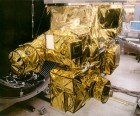 The Magnetosphere Imaging Instrument (MIMI) is a neutral and charged particle detection system on the CASSINI orbiter spacecraft designed to study the overall configuration and dynamics of Saturn's magnetosphere, and its interaction with the solar wind, Saturn's atmosphere, Titan, and the icy satellites.
The Magnetosphere Imaging Instrument (MIMI) is a neutral and charged particle detection system on the CASSINI orbiter spacecraft designed to study the overall configuration and dynamics of Saturn's magnetosphere, and its interaction with the solar wind, Saturn's atmosphere, Titan, and the icy satellites.
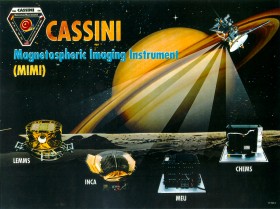 MIMI consists of three different sensors which were built at different institutions in Europe and the United States. The principal Investigator is S.M. Krimigis from the Applied Physics Laboratory of the Johns Hopkins University, Laurel, Maryland, USA.
MIMI consists of three different sensors which were built at different institutions in Europe and the United States. The principal Investigator is S.M. Krimigis from the Applied Physics Laboratory of the Johns Hopkins University, Laurel, Maryland, USA.
The different subsystems are:
- INCA (Ion Neutral Camera) built at the Applied Physics Laboratory JHU/APL Laurel, Maryland, USA
- CHEMS (Charge Energy Mass Spectrometer) built at the University of Maryland, College Park, USA
- LEMMS (Low Energy Magnetospheric Measurement System) built at Max Planck Institute for Solar System Research
- MEU (Main Electronic Unit) built at CESR, Toulouse, France and JHU/APL Laurel, Maryland, USA
Science objectives
Saturn
- Determine the global configuration and dynamics of hot plasma in the magnetosphere
of Saturn through energetic neutral particle imaging of ring current, radiation
belts, and neutral clouds.
- Study the sources of plasmas and energetic ions through in situ measurements of
energetic ion composition, spectra, charge state, and angular distributions.
- Search for, monitor, and analyze magnetospheric substorm-like activity at Saturn.
- Determine through the imaging and composition studies the magnetosphere-
satellite interactions at Saturn and understand the formation of clouds of neutral
hydrogen, nitrogen, and water products.
- Investigate the modification of satellite surfaces and atmospheres through plasma
and radiation bombardment.
- Study Titanís cometary interaction with Saturnís magnetosphere (and the solar
wind) via high-resolution imaging and in situ ion and electron measurements.
- Measure the high energy (Ee > 1 MeV, Ep 15 MeV) particle component in the
inner (L < 5 RS) magnetosphere to assess cosmic ray albedo neutron decay
(CRAND) source characteristics.
- Investigate the absorption of energetic ions and electrons by the satellites and
rings in order to determine particle losses and diffusion processes within the magnetosphere.
- Study magnetosphere-ionosphere coupling through remote sensing of aurora and
in situ measurements of precipitating energetic ions and electrons.
Jupiter
- Study ring current(s), plasma sheet, and neutral clouds in the magnetosphere and
magnetotail of Jupiter during Cassini flyby, using global imaging and in situ measurements.
Interplanetary
- Determine elemental and isotopic composition of local interstellar medium
through measurements of interstellar pickup ions.
- Study the compositional evolution at low energies of shock-accelerated ions in
the interplanetary medium.
- Monitor cosmic ray intensity variations (Ep > 70 MeV/nuc) and anomalous cosmic
rays, and compare with similar measurement in both the inner heliosphere
(Advanced Composition Explorer, ACE) and the outer heliosphere (Voyager 1, 2).
![[Top]](/images/icons/top.gif)
MIMI Investigators
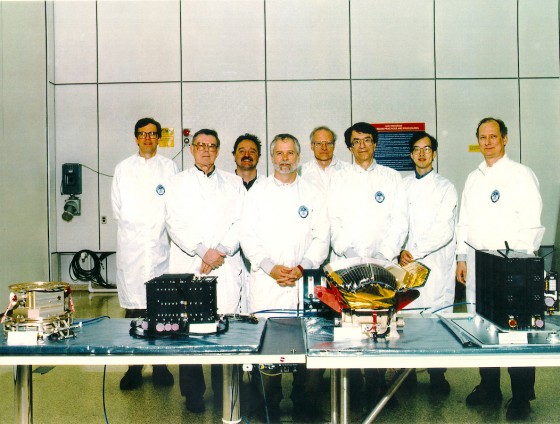
MIMI-Team leading investigators
from left to right:
B.H. Mauk, D.J. Williams, S. Livi, D. Mitchell, E.C. Roelof, S.M. Krimigis,
A.F. Cheng, D.C. Hamilton
![[Top]](/images/icons/top.gif)
MIMI Team, July 2009
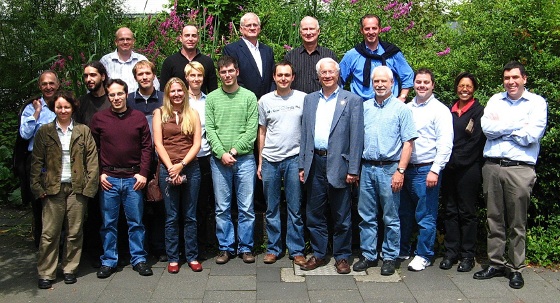
MIMI Team Meeting, Cologne, July 2009
| Principal Investigator |
S.M. Krimigis |
The Johns Hopkins University
Applied Physics Laboratory
Laurel, MD 20723
USA
Office for Space Research and Applications
Academy of Athens
Athens
Greece
|
| Team members @ APL |
A.F. Cheng
E.P. Keath (ret.)
B.H. Mauk
R.W McEntire (ret.)
D.G. Mitchell
E.C. Roelof
D.J. Williams (ret.)
M. Hill
P. Brandt
A. Rymer
T.Smith |
The Johns Hopkins University
Applied Physics Laboratory
Laurel, MD 20723
USA
|
| Team members @ Max Planck Institute for Solar System Research |
N. Krupp
J. Woch
A. Lagg
E. Roussos
E. Kirsch (ret.)
Z. Bebesi
A. L. Müller
P. Kollmann
|
Max Planck Institute for Solar System Research
Max-Planck-Str. 2
D-37191 Katlenburg-Lindau
Germany |
| Team members @ University of Cologne |
J. Saur
A. L. Müller |
University of Cologne
Institute for Geophysics and Meteorology
Zülpicher Str. 49a
D-50674 Cologne
Germany |
| Team members @ Academy of Athens |
S. M. Krimigis
N. Sergis
K. Dialynas |
Office for Space Research and Applications
Academy of Athens
Athens
Greece |
| Team members @ UMD |
G. Gloeckler
D.C. Hamilton |
University of Maryland
Department of Physics and Astronomy
College Park, MD 20742
USA |
| Team member @ UKANS |
T.P. Armstrong |
Fundamental Technology
Lawrence, Kansas
USA
affiliated with:
University of Kansas
Department of Physics and Astronomy
Lawrence, KS 66044
USA |
| Team member @ ARIZO |
K.C. Hsieh |
University of Arizona
Department of Physics
Tucson, AZ 85721
USA
|
| Team member @ SWRI |
S. Livi |
Southwest Research Institute
San Antonio
TX 28510
USA
|
| Team member @ MSSL |
G.H. Jones |
Mullard Space Science Laboratory
Holmbury St. Mary
Dorking, Surrey RH5 6NT
UK
|
| Team member @ NJIT |
L.J. Lanzerotti |
New Jersey Institute of Technology
Newark, NJ 07102
USA
|
| Team member @ NCU |
W.H. Ip |
Institute of Astronomy
National Central University
No. 300, Jungda Rd
Jungli City, Taoyuan
Taiwan 320, R.O.C.
|
![[Top]](/images/icons/top.gif)
Detailed instrument description of MIMI-LEMMS
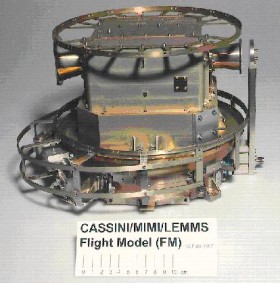 LEMMS is designed to measure the energy and spatial distribution of energetic particles (electrons and ions separately) in the interplanetary medium and in the magnetosphere of Saturn.
LEMMS is designed to measure the energy and spatial distribution of energetic particles (electrons and ions separately) in the interplanetary medium and in the magnetosphere of Saturn.
The LEMMS sensor is sponsored by the DLR (Deutsche Luft- und Raumfahrtagentur). DLR is the German counterpart of NASA.
LEMMS is based on a similar type of particle spectrometer which is currently flying on the NASA spacecraft  GALILEO orbiting the planet Jupiter. GALILEO orbiting the planet Jupiter.
LEMMS consists of the following subsystems:
 low energy detector head with collimator low energy detector head with collimator
 high energy detector head with collimator high energy detector head with collimator
 programmable turntable (manufactured in Finland by VTT) programmable turntable (manufactured in Finland by VTT)
 electronics electronics
The measurements of energetic particles are based on the loss of energy in semiconductor detectors. LEMMS has 11 different detectors E1, E2, F1, F2, A, B, D1, D2, D3a, D3b, D4
MIMI-LEMMS - Low Energy End
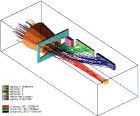 The low energy end of LEMMS is designed to measure low energy ions and electrons separately. An internal permanent magnet separates ions and electrons magnetically. The particles are detected with different detector systems inside the low energy end. The figure is the result of a simulation for the response of the low energy end of LEMMS (for details of the simulation contact Andreas Lagg (lagg@mps.mpg.de). Energetic particles enter the low energy end aperture from the left. Electrons are deflected by the magnet and counted by detectors E1, E2 (shown in green) and F1, F2 (blue) dependend on their energy. Ions are detcted by detectors A and B (shown in yellow).
The low energy end of LEMMS is designed to measure low energy ions and electrons separately. An internal permanent magnet separates ions and electrons magnetically. The particles are detected with different detector systems inside the low energy end. The figure is the result of a simulation for the response of the low energy end of LEMMS (for details of the simulation contact Andreas Lagg (lagg@mps.mpg.de). Energetic particles enter the low energy end aperture from the left. Electrons are deflected by the magnet and counted by detectors E1, E2 (shown in green) and F1, F2 (blue) dependend on their energy. Ions are detcted by detectors A and B (shown in yellow).
The whole assembly of the low energy end including the detectors E1, E2, F1, F2, A, and B and the permanent magnet are caged by a platinum box and a mu-metal shielding.
Parameter of the low energy end detectors:
| Detector |
Thickness [µm] |
Active area [mm2] |
| E1 |
300±15 |
90 |
| E2 |
300±15 |
90 |
| F1 |
700±15 |
90 |
| F2 |
300±15 |
90 |
| A |
150±15 |
35 |
| B |
700±25 |
35 |
Between detectors B and the stack of D1..D4 of the high energy end a Gold-Absorber
(1000 µm, 75 mm2) is inserted to stop particles not stopped
in A or B.
MIMI-LEMMS - High Energy End
The high energy end of LEMMS is designed to measure high energy ions and electrons with a stack of 4 detectors D1, D2, D3, D4. In front of detector D1 a 25 Ķm Al-foil suppresses incoming light on results.
Parameter of the high energy end detectors:
| Detector |
Thickness [µm] |
Active area [mm2] |
| D1 |
150±15 |
100 |
| D2 |
700±25 |
150 |
| D3a |
700±25 |
150 |
| D3b |
700±25 |
150 |
| D4 |
700±25 |
150 |
(Note: Detector D3 consists of two identical detectors D3a and D3b)
MIMI-LEMMS - Turntable
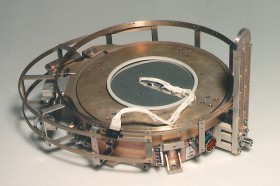 The programmable turntable was manufactured by
The programmable turntable was manufactured by  VTT in Finland. VTT in Finland.
MIMI-LEMMS - Characteristics
order of
accumulator
readout |
channel
name |
species |
logic |
low or high
energy end |
| 1 |
A0 |
ions |
A1(A2)(B1) |
L |
| 2 |
A1 |
ions |
A2(A3)(B1) |
L |
| 3 |
A2 |
ions |
A3(A4)(B1) |
L |
| 4 |
A3 |
ions |
A4(A5)(B1) |
L |
| 5 |
A4 |
ions |
A5(A6)(B1) |
L |
| 6 |
A5 |
ions |
A6(A7)(B1) |
L |
| 7 |
A6 |
ions |
A7(A8)(B1) |
L |
| 8 |
A7 |
ions |
A8(A9)(B1) |
L |
| 9 |
A8 |
ions |
A9(B1) |
L |
| 10 |
B0 |
ions |
A8(A9)B1(B5)(D41) |
L |
| 11 |
B1 |
ions |
A6(A8)B4(B5)(D41) |
L |
| 12 |
B2 |
ions |
A9B1(B5)(D41) |
L |
| 13 |
B3 |
ions |
A9B5(D41) |
L |
| 14 |
BE |
ions |
A2(A7)B1(B3)(D41) |
L |
| 15 |
C0 |
electrons |
E11(E12)(E21) |
L |
| 16 |
C1 |
electrons |
E12(E13)(E21) |
L |
| 17 |
C2 |
electrons |
E13(E14)(E21) |
L |
| 18 |
C3 |
electrons |
E14(E15)(E21) |
L |
| 19 |
C4 |
electrons |
E15(E16)(E21)+F11(F12)(F21) |
L |
| 20 |
C5 |
electrons |
F12(F13)(F21) |
L |
| 21 |
C6 |
electrons |
F13(E14)(F21) |
L |
| 22 |
C7 |
electrons |
F14(F15)(F21) |
L |
| 23 |
AS |
singles |
A1 |
L |
| 24 |
BS |
singles |
B1 |
L |
| 25 |
E11 |
singles |
E11 |
L |
| 26 |
E2F2 |
singles |
E21 |
L |
| 27 |
F11 |
singles |
F11 |
L |
| 28 |
E0 |
electrons |
D11(D12)(D21) |
H |
| 29 |
E1 |
electrons |
D11(D12)D21(D31) |
H |
| 30 |
E2 |
electrons |
(D11)D21(D22)(D31) |
H |
| 31 |
E3 |
electrons |
(D12)D21(D22)(D31) |
H |
| 32 |
E4 |
electrons |
(D12)D21(D22)D32(D33)(D41) |
H |
| 33 |
E5 |
electrons |
D21(D22)D32(D33) |
H |
| 34 |
E6 |
electrons |
D32(D33)D41(D42)(B1) |
H |
| 35 |
E7 |
electrons |
D41(D42)B1(B2) |
H |
| 36 |
G1 |
(gammas) |
(D21)D31(D32)(D41) |
H |
| 37 |
P1 |
ions |
D13(D15)(D21) |
H |
| 38 |
P2 |
ions |
D15(D16)(D21) |
H |
| 39 |
P3 |
ions |
D15(D16)D21(D23)(D31) |
H |
| 40 |
P4 |
ions |
D12(D16)D23(D24)(D31) |
H |
| 41 |
P5 |
ions |
D12(D15)D24(D25)(D31) |
H |
| 42 |
P6 |
ions |
D24(D25)D32(D34)(D41) |
H |
| 43 |
P7 |
ions |
D21(D25)D33(D35) |
H |
| 44 |
P8 |
ions |
D12(D15)D22(D23)D33 |
H |
| 45 |
P9 |
ions |
D22(D23)D32(D33) |
H |
| 46 |
H1 |
ions |
D16(D17)(D21) |
H |
| 47 |
H2 |
ions |
D16(D17)D21(D26) |
H |
| 48 |
H3 |
ions |
D25(D26)D32 |
H |
| 49 |
H4 |
ions |
D23(D25)D35 |
H |
| 50 |
H5 |
ions |
D22D34(D35)D45 |
H |
| 51 |
Z1 |
ions |
D17(D21) |
H |
| 52 |
Z2 |
ions |
D17D21(D31) |
H |
| 53 |
Z3 |
ions |
D26D32 |
H |
| 54 |
D1 |
singles |
D11 |
H |
| 55 |
D2 |
singles |
D21 |
H |
| 56 |
D3 |
singles |
D31 |
H |
| 57 |
D41 |
singles |
D41 |
H |
![[Top]](/images/icons/top.gif)
People involved with MIMI-LEMMS @ Max Planck Institute for Solar System Research (MPS)
| name |
position |
email |
| Dr. N. Krupp |
scientist |
krupp @ mps.mpg.de |
| Dr. J. Woch |
scientist |
woch @ mps.mpg.de |
| Dr. A. Lagg |
scientist |
lagg @ mps.mpg.de |
| Dr. G. Jones |
scientist |
ghj @ mssl.ucl.ac.uk |
| Dr. E. Roussos |
scientist |
roussos @ mps.mpg.de |
| Dr. Z. Bebesi |
scientist |
bebesi @ mps.mpg.de |
| A. L. Müller |
PhD student |
muellera @ mps.mpg.de |
| P. Kollmann |
PhD student |
kollmann @ mps.mpg.de |
| H. Sommer |
engineer |
-- |
| A. Loose |
engineer |
loose @ mps.mpg.de |
| K. Heerlein |
engineer |
heerlein @ mps.mpg.de |
![[Top]](/images/icons/top.gif)
MIMI-LEMMS Calibration Campaigns
| date |
location |
calibration with |
| Dec 1995 |
Goddard Space Flight Center (GSFC)
Greenbelt, Maryland, USA |
electrons |
| Mar 1996 |
Kernforschungszentrum (KFA)
Jülich, Germany |
high energy protons and helium |
| 1996-1997 |
Max Planck Institute for Solar System Research,
Katlenburg-Lindau, Germany |
low energy protons, helium, oxygen |
| Feb 1997 |
Goddard Spaceflight Center (GSFC)
Greenbelt, Maryland, USA |
electrons, H- |
| Mar 1997 |
LBL, Berkeley,
California, USA |
high energy protons, helium, carbon, oxygen |
|
